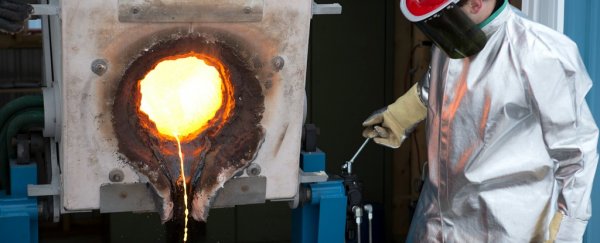Researchers from the US are making their own lava in the lab to help with a series of explosive experiments that will take place later this summer.
The goal of these experiments is to further examine how lava and water interact, especially in ice-covered volcanoes like Iceland's Eyjafjallajökull, which sent a giant ash cloud into the sky in 2010, grounding air traffic across Europe.
"The eruption at Eyjafjallajökull was more explosive due to the presence of water," said project lead Ingo Sonder, from the University of Buffalo. "Events like that don't happen often, but there is a threat of a big impact when they do. As geologists, we want to understand the conditions that generate explosions – how much water do you need? How much time?"
To study how these interactions play out in the real world, the team plans to create lava in the lab and then inject batches of it with water to see what happens. While similar experiments have already been performed, none have come close to the new experiment's scale.
"Previous studies have used a coffee cup-sized amount of lava," said geology postdoctoral researcher, Alison Graettinger. "They did it at a small-scale. We're doing it bigger, because there are a lot of questions about whether we'll see the same results when experiments are scaled up."
To pull it off, the team will take basalt – a type of volcanic rock – and heat it inside a magnetic induction furnace, melting the rock at 1,371 degrees Celsius (2,500 degrees Fahrenheit).
The molten rock will then be kept at that temperature for 3 hours, and stirred frequently using a steel rod. When all is said and done, the lava will get poured into a 10-gallon (38-litre) trough for experimentation.
You can see the team's lava recipe below:
 Bob Wilder
Bob Wilder
Obviously, this is some pretty dangerous stuff. To work on it safely, team members pouring the lava will wear bright reflective suits and gloves with a green shield over their faces to protect from infrared radiation.
 Bob Wilder
Bob Wilder
Despite the dangers, the researchers are super-excited to start, since what they're about to do has never been done before at this scale. Right now, the results are unknown.
"It's exciting to be doing this science," said Graettinger. "No one has done it before on this scale, and these lava-water interactions aren't well understood. Sometimes when water and lava meet, the lava will appear to completely ignore the water. Sometimes, the lava will cool and form distinctive cracking patterns, or form interesting shapes like pillow lavas. And sometimes, the reaction is violent. Why?"
They're now perfecting their lava-making methods to ensure they have it down before the actual experiments occur later this year. If they are successful, their findings might shed light on how water and lava interact, helping us understand the threat posed by volcanoes near water sources.
Sonder and co. aren't the only researchers unravelling volcanic mysteries - earlier this month, scientists from Germany used high-speed video footage to finally understand what causes volcanic lightning, and these scientists have been cooking steak on their lab-made lava.
Hopefully, as we find new and exciting ways to study lava and volcanoes themselves, we'll continue to get a better understanding of how volcanoes and their monstrous mountains of lava operate as a whole, and how communities can better protect themselves from the dangers associated with eruptions.
Here's that lava steak cooking again, because how could you not love it:
